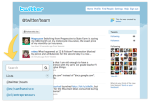October 2009
Monthly Archive
10/29/2009
Other Twitter Topics: Marketing at Twitter Speed Multiple Account Layering Strategy Social Media: Not Just for Kids Email The Scoopdog Team


+++++++++++++++++++++++++++++++++++++++++++++++++++++++++
 Some companies approach employee social media participation from the starting point of: “we hire smart people… they will do the right thing… we trust ‘em and the company benefits when our people are participating in the larger conversation…” Other firms are deeply cautious of the new scale/scope and install policies as an extension of the PR/AR/IR process: “only a very narrow approved list can play and then, only with copy that has been pre-approved with a Legal dept. scrub…”.
Some companies approach employee social media participation from the starting point of: “we hire smart people… they will do the right thing… we trust ‘em and the company benefits when our people are participating in the larger conversation…” Other firms are deeply cautious of the new scale/scope and install policies as an extension of the PR/AR/IR process: “only a very narrow approved list can play and then, only with copy that has been pre-approved with a Legal dept. scrub…”.
Perhaps it’s a natural evolution, from one end of the spectrum to the other.
If you happen to be a B2B marketer caught anywhere else than in the “we trust you” space, using social media networks, Twitter in particular, can be unexpectedly challenging. Here, let’s explore solutions to two of the more common challenges for navigating the real-time and tweet approval maze.
Challenge 1: Content Approval Not Aligned to Risk
For B2B, Twitter catalysts group very naturally into predictable categories. The list here is a starting point, depending on your segments and how granular you might want to get. Chime in w/others that you think make sense.
- Events/tradeshows and associated panels and presentations
- Educational opportunities, webinars
- Content Assets (new whitepapers, videos
- Product and/or Technology milestones/launches
- Re-tweets of posts by others to keep the buzz alive
- Product and trade news
- Investor relations/financial-related news
A starting point for conversation w/the approval/Legal team: conceptually, present the idea that Twitter participation falls into predictable categories: many very low risk, some with higher risk, some peppered with significant risk.
A solution: Strive for an agreement with the approval team that risk levels vary and that approvals should scale in alignment to risk. Then, focus on the content types with little/low risk. For high risk content like financial transactions, earnings calls, acquisitions, etc. content may always need to undergo a rigorous and very specific scrub. As well, AR/PR/IR tweets will usually be in the hands of company media professionals rather than the day-to-day marketing leads.
Challenge 2: Marketing Participation Real-Time
When social media participation policy is an extension of PR/AR/IR practices, a consequence is that the thinking around review/approval is tied to historic and old-media cycle time. Twitter and buzz opportunities move faster and break the mold. Marketing needs a pathway to participation that is both corporately safe as well as sales-useful.
A solution: Narrow the Twitter participant list to approved spokespersons from the marketing and product teams already media trained. Add additional training on the nature of the social media beast. Partner w/Legal on the training content so governance and risk issues are illuminated and addressed.
A solution: In advance of need, work w/the approval team to pre-qualify Twitter content and approach. The strategy is to define an approved architecture for tweet-types which then both complies with the approval policy and frees Tweeters to participate spontaneously w/out risk or delay.
As examples, here’s a few generic approaches relating to event/tradeshow speaker presentations, panel discussions and downloadable media assets:
“Check out (company name) and boothxxxx at (event name); stop by for (a chance to win… product demo… special presentation… etc.).”
“Attending (event name)? (Name/Title) from (Company Name) will present a paper on (topic) in (location)(time). Listen in, join the conversation (link to presentation/paper abstract)”
“Listening to (names and companies) and the (panel title) discuss (panel topic). For a deeper dive, visit (your company name) at (link)”
“New analyst whitepaper on (topic) for download. Visit (link) for a closer look at (product and/or technology description).
You get the idea. By being armed w/ a pre-approved architecture, marketing should be better able to participate.
*****************************************************************************
Welcome! If you like/are interested in B2B Marketing, the Agency-Client Relationship discussion and/or other Marcom mysteries,  please subscribe to my RSS feed.
please subscribe to my RSS feed.
10/08/2009
Other Twitter Topics: Marketing at Twitter Speed Multiple Account Layering Strategy Social Media: Not Just for Kids Email The Scoopdog Team


+++++++++++++++++++++++++++++++++++++++++++++++++++++++++
 (Read time = ~2 minutes) With only 140 characters, body language missing… no context or context of only 1/2 a conversation and no ability to “look your counterpart in the eye”… are you communicating well? Is the messaging coming across the way you intend?
(Read time = ~2 minutes) With only 140 characters, body language missing… no context or context of only 1/2 a conversation and no ability to “look your counterpart in the eye”… are you communicating well? Is the messaging coming across the way you intend?
Double think before you click, or risk suffering the consequences,.
Real time case study: An electronic firm last week issued news as part of a product line refresh. Features and functionality were nicely added. An editor for a European publication covering the story dropped on “creative” headline playing off current television jargon: “(company name) pimps out new (XXX product name)…”. No sooner than the story hit, tweets began to fly – exactly as I’m sure the editor wanted.
Inside the client company, angst occurred despite the story content being very positive. Use of “pimp” in the headline caused many to argue against re-tweets and references. After an email flurry, the more younger marketers quickly pointed out a distinction between use of the word as a verb (ie, “pimping out your ride”) v. use of the word as a noun. The former is actually a positive reference for “refresh”, “retool”, and/or “re-spin”.
The discussion brought to mind one of the difficulties facing marketers, Agencies and consultants when dealing w/Twitter, in particular. the real-time nature of communications can often cause fingers to fly across the keyboard ending in “enter” w/out sufficient time for thinking or understanding.
Add now Google’s testing of its Wave (new email platform) application with keystroke-by-keystroke visibility and there will soon be another very misunderstood-prone platform available.
Most of us have experienced receiving email responses predicated on only the first sentence or two… worse, email responses based only on a subject line and zero reading of the actual email body itself. (I confess, I’m guilty here). So, just a word of caution as highlighted by last week’s client experience and a classic case of Twitter misunderstanding.
Go fast, but slowly.
*****************************************************************************
Welcome! If you like/are interested in B2B Marketing, the Agency-Client Relationship discussion and/or other Marcom mysteries,  please subscribe to my RSS feed.
please subscribe to my RSS feed.
10/06/2009
Posted by scoopdog under
Marcom for B2B
[2] Comments
Other Twitter Topics: Marketing at Twitter Speed Multiple Account Layering Strategy Social Media: Not Just for Kids Email The Scoopdog Team


+++++++++++++++++++++++++++++++++++++++++++++++++++++++++
 (Read time = ~3 minutes) Following on its last May promise to further clarify Fair Trade Commission guidelines regarding disclosure rules and paid endorsements/testimonials, the FTC Monday issued notice of changes to its Guides Concerning the Use of Endorsements and Testimonials in Advertising, calling out behavior specific to blogger engagements and paid-per- tweet services.
(Read time = ~3 minutes) Following on its last May promise to further clarify Fair Trade Commission guidelines regarding disclosure rules and paid endorsements/testimonials, the FTC Monday issued notice of changes to its Guides Concerning the Use of Endorsements and Testimonials in Advertising, calling out behavior specific to blogger engagements and paid-per- tweet services.
The Guides are interpretations of law, intended to help advertising and companies comply w/the FTC Act. The Guides were last updated in 1980. Companies, bloggers and other “word-of-mouth” marketers are advised to disclose any “material connections” (payments or receipt of merchandise and/or service, in kind) that consumers would not expect.
Why Care: A Use Case of Accidental Endorsement
Because “paid endorsement” no longer is limited to hard cash, the line blurs quickly for many engaged in the larger conversation. Imaging you’re attending you’re attending the next industry tradeshow. Company A circulates a TweetUp! call and gathering at the second-floor bar. Drinks are freely poured while a product demonstration occurs and management touts the latest and greatest benefits and functionality. Impressed, you tweet the event and comment, ever so briefly, on the product demo, availability and/or functional improvements. A blogger (or two) in the crowd reports on the event and reactions. Have you unwittingly become a “word of mouth” conduit for endorsement? What are the disclosure rules that apply? Where is the line?
We may need a hastag colution to quickly/easily communicate the “sponsorship/payment” case. How about #$… #$$…. #$$$ depending on the amount of compensation? (thanx @spookwrite)
Transparency is goodness, and the policy is aimed at correcting deceptive practices, but it could easily become uncomfortable for those engaged in adding a voice to the larger, social conversation to think that a disgruntled response to a blog post, tweet or Facebook comment might escalate. And for marketers using or thinking of using on-line and social media strategies to push messaging and sustain the buzz, be wary… be smart. Are you at risk of being an unwitting “word-of-mouth” endorser, and therefore having behavior subject to FTC regulation?
Twitter is not specifically mentioned, but the Guides do call out “celebrity endorsement as relates to advertising regulation. TechCrunch in July, did a thoughtful recap of pay-per-tweet networks such as Izea, TweetROI, Twittad and Magpie. Very worthwhile for marketers to pay close attention. What are the implications for personal branding behavior?
The FTC did write that it will review cases one-by-one so evolution of the interpretation will occur. Consider also that In traditional journalism circles, produce reviewers are often provided product for investigation and perhaps public comment. Widely, the products are kept by the reviewer/service yet not always disclosed. This new FTC Guide seems to distinguish bloggers, in particular, as not being legitimate news resources and more simply advertising shill. An unfortunate conclusion.
Oh, and by the way… on-line services and bloggers, in particular,were first to bring the news public. If that’s not journalism, dunno what is… Several resources writing on the topic
Should all make for an even more interesting Blog World & New Media Expo beginning Oct. 15. Can’t wait.
*****************************************************************************
Welcome! If you like/are interested in B2B Marketing, the Agency-Client Relationship discussion and/or other Marcom mysteries,  please subscribe to my RSS feed.
please subscribe to my RSS feed.
10/05/2009
Other Twitter Topics: Marketing at Twitter Speed Multiple Account Layering Strategy Social Media: Not Just for Kids Email The Scoopdog Team


+++++++++++++++++++++++++++++++++++++++++++++++++++++++++
 (Read time = 2-3 minutes) A previous ScoopD blog post illuminated the emerging dilemma for marcom practitioners driving their companies to social media best practices; namely the appropriate role of legal approval in the social media communications process. As often happens in today’s social media, the post opened up a whole can of virtual and viral worms. Here, contributor Chuck Byers takes the conversation a layer deeper w/regard/to striking an appropriate balance between protection, real-time marketing and freedom of expression.
(Read time = 2-3 minutes) A previous ScoopD blog post illuminated the emerging dilemma for marcom practitioners driving their companies to social media best practices; namely the appropriate role of legal approval in the social media communications process. As often happens in today’s social media, the post opened up a whole can of virtual and viral worms. Here, contributor Chuck Byers takes the conversation a layer deeper w/regard/to striking an appropriate balance between protection, real-time marketing and freedom of expression.
This isn’t going to be an entertaining rant on the intrusion of our legal colleagues into the creative and messaging process (although such is tempting) because the truth is this sometimes acrimonious dialog is historic and on-going. And ultimately, I’m going to ask you to share your best practices because, quite frankly, the role of legal and marcom in corporate social media is evolving.
At the outset, let’s acknowledge that there are enormous and legitimate legal concerns. I’m not a lawyer but it is obvious that an entity is at legal risk nearly anytime it communicates with its constituents. It used to be that biggest worries were having a corporate officer mutter something untoward into an unsuspected open microphone or in a mistakenly “off-the-record” interview. These risks are compounded in legal’s eyes by the litigious nature of today’s society, shareholder activism, and competitive business practices.
There are clearly additional concerns over the implications and mis-steps of the speed of information exchange and the breadth of information reach. The worldwide web isn’t called www for nothing and the ability to injure, harm or offend spreads as wide as the ability to enhance societal justice. Trumping all considerations is the necessary ability to catalog, store, retrieve and produce — or more importantly legally protect and defend — material that could be potentially determined to be discoverable.
That said, what is the appropriate balance between legal protection, marketing, freedom of expression and capitalizing on the spontaneity and interactivity of the social media for the social good? How do companies balance these two historically orthogonal perspectives when there appear to be a range of corporate policies and cultures at play?
At one end, there is a technology company with a very active robust social media department who designates specific individual to be their social media communicators. These individuals are charged with using good taste, a thoughtful consideration for the power of their words and deeds, a culture that reinforces that they are the company’s representatives and that they are the trusted messenger of the company’s good will. Within these boundaries, they are charged to maximize all facets of social media for the company good … blogs, tweets, FaceBook and even virtual reality.
At the other end, there are companies whose legal departments are insisting that they need to approve an 89-character tweet that point’s customers to the company’s latest new product announcement.
So where is the middle ground? As communicators we would clearly prefer the former to the latter. But this not Utopia and not every company is going to be so liberal
What are the best practices? We call upon the wiki-power of the blogosphere for the answers. Share your experiences, best practices and worst practices. The ScoopD team hopes to gather feedback with the intent to begin dialogue leading to a sense of direction.
And in the best spirit of social media, we will share all in what we hope will be a consensus seeking exercise. Follow http://www.twitter.com/maddogprofessor on Twitter and let’s begin trading ideas.
*****************************************************************************
Welcome! If you like/are interested in B2B Marketing, the Agency-Client Relationship discussion and/or other Marcom mysteries,  please subscribe to my RSS feed.
please subscribe to my RSS feed.
10/01/2009
Other Twitter Topics: Marketing at Twitter Speed Multiple Account Layering Strategy Social Media: Not Just for Kids Email The Scoopdog Team


+++++++++++++++++++++++++++++++++++++++++++++++++++++++++
 (Read time = 1 minute) One of the tantilizing promises Twitter holds out for B2B marketers is the direct marketing possibility of “narrow-casting“, ie: the ability to segment Twitter accounts into very vertical groups for rifle-shot messaging and campaigns. To this point, beyond brute strength, there’s been little easy way to attack the issue. Now, all that may be changing. Twitter HQ announced 9/30 that a “list” feature test has been rolled-out to a select few accounts.
(Read time = 1 minute) One of the tantilizing promises Twitter holds out for B2B marketers is the direct marketing possibility of “narrow-casting“, ie: the ability to segment Twitter accounts into very vertical groups for rifle-shot messaging and campaigns. To this point, beyond brute strength, there’s been little easy way to attack the issue. Now, all that may be changing. Twitter HQ announced 9/30 that a “list” feature test has been rolled-out to a select few accounts.
Little beyond the initial blog post is known, but depending on functionality, this is definitely a topic to keep on Agency, Marketing and Consultant radars. On a practical side/personal side, for those following hundreds (thousands?), a list feature would be one additional way to keep the conversations sane.
Below is a quick recap where the announcement is being discussed…
Chek Out the Coverage: Will Add More in Real-Time
10/1: WIRED Weighs-in
From the Twitter blog: Soon to Launch: Lists. Nick Kallen, project lead for Twitter on Lists, wrote 9/30 about the small test of this new feature with a subset of Twitter accounts.
Technology Cutting-Edge Blogger Louis Gray on Twitter Lists
LATimes Business Technology News: Mark Milian reports in Kusts and the LAT’s test run.
Geeksugar – No date for public rollout but “coming soon…”
Scoble on Lists: Well-known blogger Robert Scoble rants on Twitter’s “suggested user list”
Appscout.com, republished by PCMagazine.com – Lists will be public by default but can be made private…
*****************************************************************************
Welcome! If you like/are interested in B2B Marketing, the Agency-Client Relationship discussion and/or other Marcom mysteries,  please subscribe to my RSS feed.
please subscribe to my RSS feed.
 Some companies approach employee social media participation from the starting point of: “we hire smart people… they will do the right thing… we trust ‘em and the company benefits when our people are participating in the larger conversation…” Other firms are deeply cautious of the new scale/scope and install policies as an extension of the PR/AR/IR process: “only a very narrow approved list can play and then, only with copy that has been pre-approved with a Legal dept. scrub…”.
Some companies approach employee social media participation from the starting point of: “we hire smart people… they will do the right thing… we trust ‘em and the company benefits when our people are participating in the larger conversation…” Other firms are deeply cautious of the new scale/scope and install policies as an extension of the PR/AR/IR process: “only a very narrow approved list can play and then, only with copy that has been pre-approved with a Legal dept. scrub…”.![]() please subscribe to my RSS feed.
please subscribe to my RSS feed.
 (Read time = ~2 minutes) With only 140 characters, body language missing… no context or context of only 1/2 a conversation and no ability to “look your counterpart in the eye”… are you communicating well? Is the messaging coming across the way you intend?
(Read time = ~2 minutes) With only 140 characters, body language missing… no context or context of only 1/2 a conversation and no ability to “look your counterpart in the eye”… are you communicating well? Is the messaging coming across the way you intend? (Read time = ~3 minutes) Following on its last May promise to further clarify Fair Trade Commission guidelines regarding disclosure rules and paid endorsements/testimonials, the FTC
(Read time = ~3 minutes) Following on its last May promise to further clarify Fair Trade Commission guidelines regarding disclosure rules and paid endorsements/testimonials, the FTC  (Read time = 2-3 minutes) A previous ScoopD blog post illuminated the emerging dilemma for marcom practitioners driving their companies to social media best practices; namely the appropriate
(Read time = 2-3 minutes) A previous ScoopD blog post illuminated the emerging dilemma for marcom practitioners driving their companies to social media best practices; namely the appropriate  (Read time = 1 minute) One of the tantilizing promises Twitter holds out for B2B marketers is the direct marketing possibility of “narrow-casting“, ie: the ability to segment Twitter accounts into very vertical groups for rifle-shot messaging and campaigns. To this point, beyond brute strength, there’s been little easy way to attack the issue. Now, all that may be changing. Twitter HQ announced 9/30 that a “list” feature test has been rolled-out to a select few accounts.
(Read time = 1 minute) One of the tantilizing promises Twitter holds out for B2B marketers is the direct marketing possibility of “narrow-casting“, ie: the ability to segment Twitter accounts into very vertical groups for rifle-shot messaging and campaigns. To this point, beyond brute strength, there’s been little easy way to attack the issue. Now, all that may be changing. Twitter HQ announced 9/30 that a “list” feature test has been rolled-out to a select few accounts. Follow ScoopDog
Follow ScoopDog Join My Network
Join My Network
